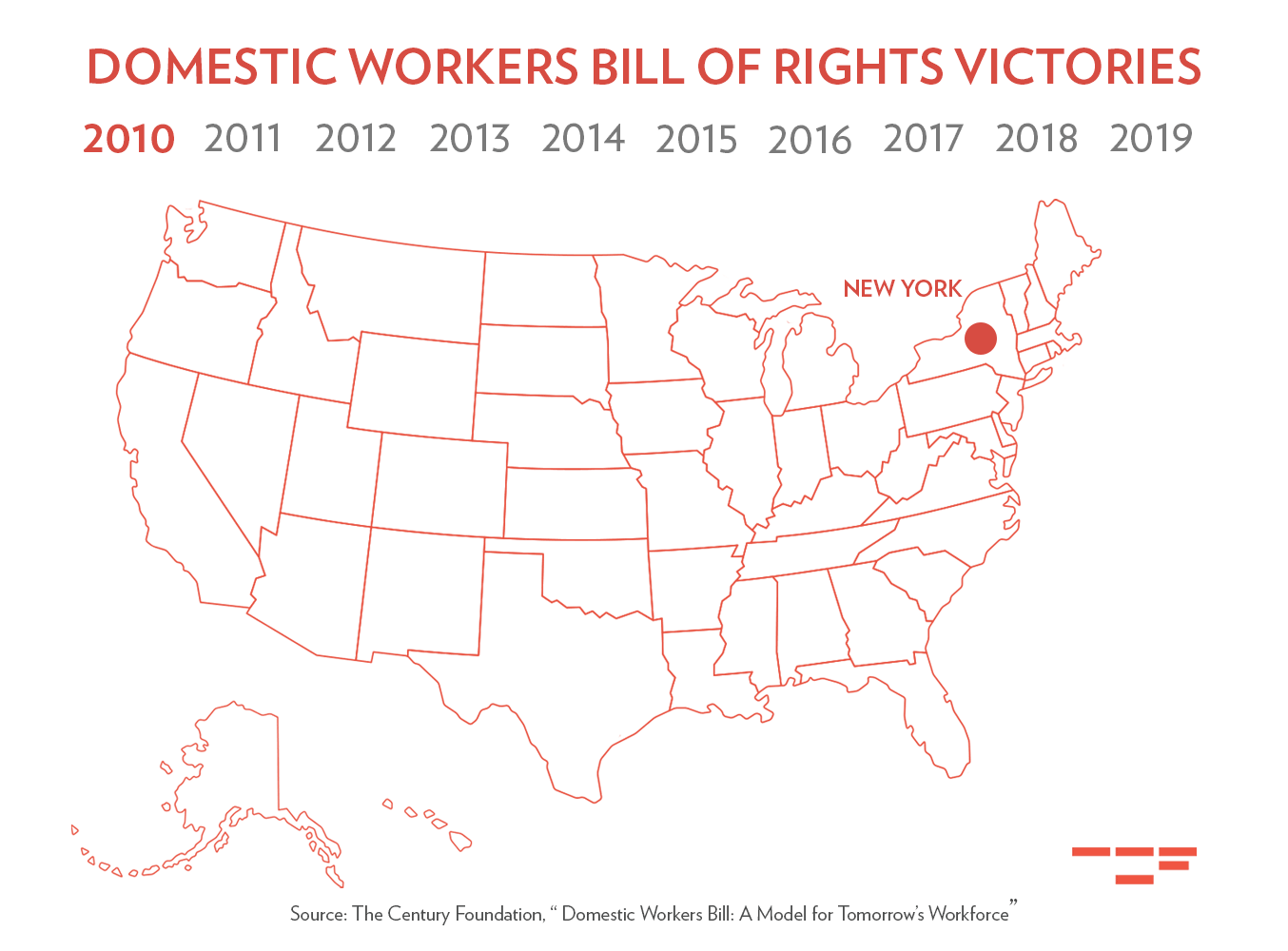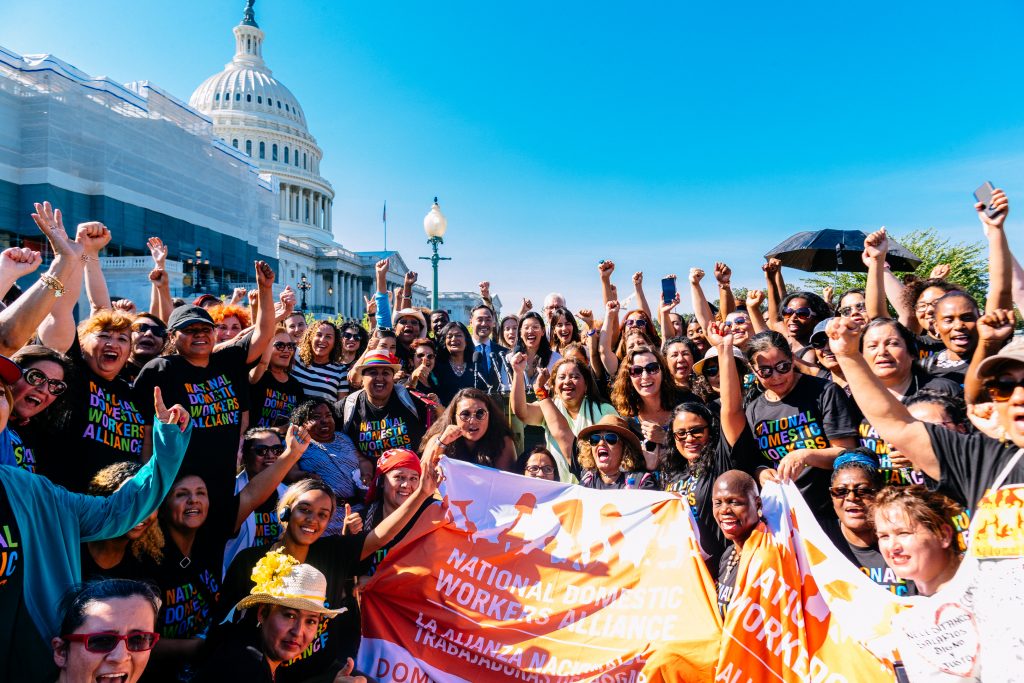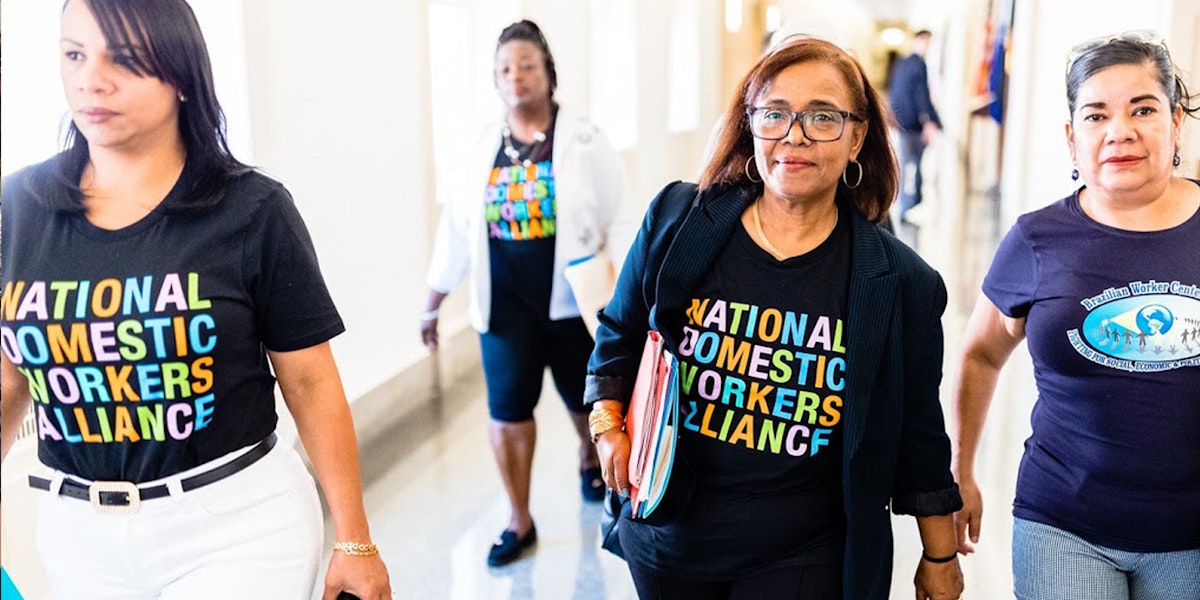At the press conference announcing the introduction of the first-ever national Domestic Workers Bill of Rights in Congress, Silvia Gonzalez, a domestic worker from Seattle,1 shared her story and spoke about the importance of passing such a bill for domestic workers:
My name is Silvia Gonzales. I am a domestic worker, an immigrant, and a mother, and I am proud to organize other domestic workers. In one of my jobs as a house cleaner, I fell in the bathroom and I hurt my head, hip, and arm. I did not have any options to report the incident so I had to pay the hospital and physical therapy bills. This story is very common—I know many house cleaners who have fallen down the stairs and could not walk or work for several weeks. In addition to having to pay for all of the medical bills, they lose income from the days they are unable to work.
I was proud to be part of the fight in Seattle to win a Domestic Workers Bill of Rights. In addition to setting certain standards, like time off and written agreements, we established the first Standards Board for the industry, where workers like me who were named as a part of the board can have a dialogue with employers to establish new standards and programs for this unique industry—where the workplace is a home. That is why I am so excited to be here today so the victories we won in Seattle and nine states can be extended to workers all around the country.
In order to help make domestic work visible, safe, fair, and dignified, on July 15, 2019, Senator Kamala Harris (D-CA) and Representative Pramila Jayapal (D-WA) introduced the Domestic Workers Bill of Rights Act, S. 2112/H.R. 3760.2 This comprehensive, 158-page bill, developed with input from domestic workers and leaders at the National Domestic Workers Alliance (NDWA),3 guarantees common workplace rights and protections to domestic workers, creates new policies to address the unique challenges of the labor they perform, and includes strong implementation and enforcement policies.
The Domestic Workers Bill of Rights (hereafter referred to as “The Domestic Workers Bill of Rights,” “the Bill of Rights,” or “the bill”) is also a model of innovation for other sectors as policymakers consider what laws are needed to ensure an inclusive and equitable future for work. Domestic workers are often considered “the original gig workers”4 because they have long known the precariousness of low wages, job insecurity, few to no benefits, wage theft, and other conditions that workers in many more sectors are facing today. Worker power has been eroding across the economy, declining as corporate interests and the wealthy few amass wealth and power at the expense of unions and other advocates for worker voices, workers’ rights, decent wages, and good jobs.5 Therefore the solutions in the Bill of Rights, while sector-specific and designed to address the needs of this historically marginalized workforce, provide a rubric for using policy to stop the widespread erosion of worker power and rights in any industry.
This report will illustrate that universal applicability by identifying and describing the six innovations in the bill that most provide a model for a secure and thriving future for workers in sectors beyond domestic work. In particular, the bill provides creative examples for a sectoral approach to the setting of standards; maintaining the affordability of services while increasing investments in the workforce; enforcement for low-wage sectors; and workplace harassment. The bill ensures that a historically marginalized and undervalued sector receives fair treatment regardless of their work arrangement, including by:
- using inclusive definitions that cover everyone working in the sector regardless of work arrangement;
- creating a mechanism for sectoral bargaining in the form of a wage and standards board that brings together workers, employers, the government, and the public to make recommendations about working conditions, including living wages;
- addressing the need for universal, portable benefits;
- investing in domestic work from the perspective of affordability for families and raising standards for the workforce, rather than pitting these two needs against each other;
- awarding grants to community organizations that domestic workers trust so that they can partner with government agencies to support education, outreach, and co-enforcement, since workplace protections are only as good as their enforcement; and
- guaranteeing workers the right not to be discriminated against or harassed at work.
Before going into the details of the bill, it’s helpful to set the context. In the next section, I will provide an overview of the domestic work sector and of the needs that the bill is designed to meet.
The Demographics and Discriminatory History of Domestic Work
More than 2 million domestic workers across the United States do the work of caring for children, elderly loved ones, and homes, or of helping people with disabilities live independent lives.6 They are home care workers, nannies, and house cleaners, and they comprise a large and growing workforce whose work, for the most part, won’t be automated or outsourced abroad. In fact, home health aides and personal care assistants are the third and fourth fastest growing occupations in the United States according to the Bureau of Labor Statistics (BLS),7 largely due to the rapidly growing population of elder Americans (more people are living longer).8 In fact, the number of people in the United States aged 65 and older is projected to more than double between 2015 and 2060, and population growth will be particularly rapid among adults aged 85 and older.9
Over 90 percent of domestic workers are women, and a majority are immigrant, Black, and other women of color.10 Some domestic workers live in the homes of their employers, while others do not. Some have multiple clients at a time; others have many clients over the course of a longer duration of time. Some work for agencies, while many work one-on-one directly for a client–employer. Their work conditions vary dramatically, because of many different factors; but the majority of the domestic workforce receive low wages and labor in poor working conditions.
The history of domestic work is a picture painted with racism, sexism, and xenophobia: all three are endemic to the sector, throughout the past and to this very day.
The history of domestic work is a picture painted with racism, sexism, and xenophobia: all three are endemic to the sector, throughout the past and to this very day. In the United States, paid domestic work has historically been performed by Black and immigrant women. Black women—first when they were enslaved and then as freed people—worked as housekeepers, nannies, and cooks in the North and West. In fact, until more opportunities were opened to them in the 1960s, domestic work was often one of the few occupations open to Black women.11 Meanwhile, in the North, Irish immigrants often took domestic jobs, as did Asian and Latina immigrants in the West.12 Today, the field continues to be dominated by immigrants and women of color.
Just as paid domestic workers were, and continue to be, undervalued and poorly treated, many other women were—and continue to be—doing the same work for no pay. Unpaid domestic work performed by women for their families does not count in any official government measures as “hours worked” or as having any monetary value, 13 but has an estimated economic value of $470 billion.14 Yet, it is essential work that makes all other work possible and deserves to be valued.
The Rights of Domestic Workers Today
When the U.S. Congress passed labor rights laws in the 1930s, discriminatory perspectives were given an outsized voice. As Premilla Nadasen and Tiffany Williams write, “When New Deal labor legislation was enacted in the 1930s, Southern Congressmen, concerned about maintaining control over the African American labor force, insisted on the exclusion of domestic and agricultural workers from Social Security, minimum wage and overtime (the Fair Labor Standards Act, FLSA), and collective bargaining laws (the National Labor Relations Act, NLRA).”15 It took until 1950 for domestic workers to be included in Social Security. Thanks to the organizing and leadership of African-American domestic workers, in 1974, more domestic workers were included in minimum wage and overtime protections.16 In 2013, the Home Care Rule implemented by the Obama administration closed a large part of the remaining gap by narrowing the “companionship exemption” to make home care workers’ inclusion under FLSA protections unambiguous and explicit.17
Unfortunately, misconceptions in media and the news have left much to be desired in terms of the general awareness of these protections. Because NDWA, the most active advocacy organization in the space, often talks about the historic exclusions from labor laws in the context of the need for new rights, some journalists and experts have mistakenly reported that domestic workers don’t currently have the right to the minimum wage and overtime. It’s important that domestic workers, those who employ them, and those who enforce the law know that these workers are covered by FLSA. The only remaining exception is that live-in domestic workers who are paid by private households are currently exempt from overtime pay, which would be remedied by the Domestic Workers Bill of Rights; and that in some states, domestic workers are not covered by state minimum wage laws that are higher than the federal minimum wage, or state-level overtime protections.
At the same time, the right to unionize, granted via the NLRA, generally does not include domestic workers.18 They are also excluded from the Occupational Safety and Health (OSH) Act,19 which assures safe and healthful working conditions for working men and women.20 In addition, laws like the Civil Rights Act and the Family and Medical Leave Act (FMLA), because of their employee thresholds (wherein only employers who employ a specific number of employees are covered—fifteen for the Civil Rights Act, and fifty for FMLA), exclude many domestic workers who work for smaller employers.

Domestic workers in states and cities around the country have been organizing to counteract these federal exclusions. They have won state and local Domestic Workers Bills of Rights in nine states and two cities. New York was the first state to enact such a bill in 2010,21 and since then, Hawaii (2013),22 California (2013 and 2016),23 Massachusetts (2014),24 Connecticut (2015),25 Oregon (2015),26 Illinois (2016),27 Nevada (2017),28 and New Mexico (2019)29 have followed suit. Municipal Domestic Workers Bills of Rights have passed in Seattle (2018)30 and Philadelphia (2019).31 These state and local bills differ amongst themselves in terms of focus and comprehensiveness, but all grant new rights and protections to domestic workers.
All told, while much work remains to be done, a great deal of progress has been made in the last decade. The strategies that the domestic worker movement has used to advance legislative victories at the state, local, and national levels provide a useful model for other sectors. In many states, employment laws, which have often been modeled off of the original federal laws, similarly exclude domestic workers—in some cases by design, in others by default. It is as important to remedy these state exclusions as it is to remedy the federal exclusions, both to make change at every level where workplace laws exist and because state and local laws can serve as models for national policymaking. Many of the provisions of the national Domestic Workers Bill of Rights were based on state and local models; but there are still millions of domestic workers in the forty-one remaining states without a domestic worker bill of rights who are left with inadequate protections. National legislation is needed to raise standards for domestic workers in all fifty states.
Six Key Innovations in the National Domestic Workers Bill of Rights—and the Model They Provide
The unique nature of domestic work makes it important to have a sector-specific approach to ensuring rights and protections for its workforce: work arrangements can vary dramatically in the sector, and those rights and protections need to be guaranteed in every one of them. For example, domestic workers often have multiple employers, work one-on-one, work for households who don’t necessarily think of themselves as employers, and work part-time or live in the homes in which they work. They face perceptions and stereotypes with deep historical roots about the value of their work, are often misclassified as independent contractors, and sometimes work in an informal “gray economy.” Domestic workers also often lack bank accounts or access to the internet, and many do not have English as their first language.32 The national Domestic Workers Bill of Rights provides a strong model to cover all of these situations and more, and is based on the principle that there is a set of legal rights and protections that everyone who works deserves to have.
While the policy solutions in the national Domestic Workers Bill of Rights are specific to domestic work, they also provide innovative and relevant models for other sectors. In many cases, by looking to those in the margins—like domestic workers—and observing how they and their allies are advocating for their rights, one can find in their work the most innovative solutions for ensuring justice and equity. The six innovations highlighted below are important for domestic workers; but given the broad applicability of the philosophies behind them, I will present them in terms that make their translatability to other sectors clear.
Innovation #1: Inclusive Definitions of Who Is Covered
The bill uses broad definitions to describe domestic workers and those who hire them to help ensure that domestic workers are covered regardless of their work arrangement. Building off the approach used in the Seattle Domestic Workers Bill of Rights, the broad definitions of “domestic workers” and “hiring entities” in the national Bill of Rights ensure that whoever hires the worker must comply with the law.33 Specifically, the bill defines “domestic worker” as an individual who is paid directly or indirectly for the performance of domestic services, including an employee as defined by the FLSA. It defines “domestic work hiring entity” as any entity that pays directly or indirectly for the performance of domestic services, including employers as defined by FLSA. These broad definitions are intentionally inclusive of domestic workers who work on online platforms or who work for an individual household through an agency.34
This insistence on broad definitions is relevant across sectors. When creating policies that support workers, it is important to design the definitions used so that they are as inclusive as possible. No matter their work arrangement or who they are working for, workers deserve the right to fair wages, benefits, and the ability to care for themselves and their families.35 As the workplace becomes more “fissured,”36 a term which—as David Weil explains—includes “offshoring, outsourcing, and use of staffing agencies that [leads] to work characterized by low wages, noncompliance with core workplace statutes, limited benefits, more contingent employment, greater risk exposure, and weakened bargaining leverage for workers in general,”37 inclusive definitions of who is covered by laws are even more important to ensure that workers are both eligible and able to access workplace rights, protections, and benefits.
Innovation #2: Sectoral Bargaining
Employers should treat workers well, not only because it is the right thing to do, but because when employees have financial security and job satisfaction and feel valued, job performance improves and turnover reduces, both of which will improve an employer’s bottom line. In addition, when workers are well-paid, they have money to spend, ensuring consumer demand and keeping the economy thriving. In domestic work, where the work involves an employer’s loved one or home, there should be additional incentives to treat people well. Unfortunately, in too many corporations, profit and shareholder value are being prioritized higher than the well-being of the workforce, including in the domestic work sector; and in the homes where domestic workers labor, too often, imbalanced power dynamics and long-standing perceptions of domestic work not being “real work” lead to exploitative and harmful workplace conditions.
Workers deserve to have a say in their working conditions, and in the case of domestic work, where the differences in power between workers and those who employ them tend to be extremely disparate, protections that ensure such a say are incredibly important. One of the major ways to ensure that workers are at the table is through unionization, collective bargaining, and/or organized participation in protected concerted activities, such as talking to coworkers about working conditions, circulating petitions asking for improvements, or talking to the media about working conditions.38 However, as noted above, the federal legal right to participate in these activities, via the NLRA, explicitly excludes most domestic workers.39 In addition, since domestic workers often work in a one-on-one employer–employee relationship, they have no “collective” with whom to bargain. As Sharon Block explains, “Setting standards workplace by workplace where domestic workers are hired by the families they serve would be impossible. Many domestic workers work for multiple employers, again making a system based on workplace by workplace standards complex.”40 In some situations, unions have been able to organize in-home workers who receive Medicaid payments from the state by making the state the employer of record and bargaining for better conditions on their behalf.41 But for most domestic workers, enterprise-based collective bargaining is not an option for these legal and practical reasons.
Workers deserve to have a say in their working conditions, and in the case of domestic work, where the differences in power between workers and those who employ them tend to be extremely disparate, protections that ensure such a say are incredibly important.
That is why the national Domestic Workers Bill of Rights includes a model for sectoral bargaining—an approach to bargaining that is performed on the behalf of an entire sector, rather than employer by employer. Specifically, the bill includes the creation of a domestic workers wage and standards board. This board would be a forum in which workers, employers, worker organizations, the government, and the public can consider, analyze, and enact recommendations to improve job quality and, specifically, promote safety, health, well-being, and living wages for workers. The domestic workers wage and standards board provision in the national bill is modeled off of a similar provision in the Seattle Domestic Workers Bill of Rights: that piece of legislation set up the first domestic workers wage and standards board in the country, bringing together a thirteen-member board to make recommendations to the city council on training, accreditation, wage standards, overtime, access to paid time off, retirement and health care benefits, workers’ compensation, and written hiring agreements. In Seattle, the board has begun to meet and consider these issues.
The national bill would require the secretary of labor to appoint ten members, based on the nominations of both worker organizations and hiring entities. Five are appointed to represent domestic workers and five are appointed to represent domestic work hiring entities. The secretary, or a designee, also serves on the board as the eleventh member. The board makes recommendations to the secretary of labor including, but not limited to: minimum wages for domestic workers; workplace standards; facilitating enforcement; domestic worker benefits; and any other subject approved by the board. For any issue not within the secretary’s authority, they shall make a recommendation to Congress to do an expedited review and take action on the issue. But for recommendations that do fall under the secretary’s purview, they have ninety days to accept, reject, or recommend modifications to the board’s report and recommendations. If the secretary chooses to deviate from the board’s recommendations, they must issue a public report to Congress outlining why the recommendations were altered or disregarded. Upon accepting a recommendation, the secretary of labor shall adopt rules and regulations necessary to carry them out. If they wish, states and localities are allowed to set higher wage or working condition standards than the national board does: the national legislation mandates a floor, but not a ceiling.
In addition to the Seattle model, the national Domestic Workers Bill of Rights builds on wage boards that have shown success in other industries. For example, in New York State, a wage board was the basis for a tripartite negotiation among workers, businesses, and government that led to fast food workers receiving a $15 minimum wage. Later, the legislature extended this to all workers in New York.42 This type of model makes more and more sense as the nature of labor markets and of the workforce changes. As David Madland and Adam Stromme write of the Bill of Rights, “The legislation takes an innovative approach to raising standards that is well-suited to domestic work and may also provide a model for other types of jobs that increasingly resemble domestic work.”43
Innovation #3: Universal, Portable Benefits
In “Designing Portable Benefits: A Resource Guide for Policymakers,” Libby Reder, Shelly Steward, and Natalie Foster make the case that those classified as “non-traditional” workers—including domestic workers—need “workplace benefits that map to the reality of their work arrangement(s).”44 It’s important to ensure that work arrangements don’t hinder people from accessing benefits. A framework in which benefits are both universal (available to all workers across a sector) and portable (tied to each worker and not contingent on employment status or working a certain number of hours for a single employer) can guarantee benefits across the sector regardless of work arrangement.
The national Domestic Workers Bill of Rights ensures that domestic workers can earn paid sick days, and it calls for studies that will identify barriers to domestic workers’ access to work-related benefits such as health insurance45 and retirement security46—since few domestic workers have these or other benefits like unemployment insurance, workers compensation, or disability insurance. It also requires the development of improvements to existing programs as well as the development of new ones that are more inclusive. One initiative it could review is the National Domestic Workers Alliance’s Alia, a portable benefits tool owned by workers that allows the clients of domestic workers—for now only house cleaners—to contribute to benefits like paid time off and disability insurance. In addition, the national board’s studies could examine and learn from state and local government innovation. For example, Philadelphia’s Domestic Workers Bill of Rights establishes a portable and prorated paid sick days program that domestic workers can access regardless of work arrangement, including the number of employers they have.47
As employers turn more jobs into “nonstandard jobs”—for example, by hiring workers as independent contractors instead of employees, or by making the employer of record unclear—innovations such as broad definitions, sectoral bargaining, and universal, portable benefits are increasingly necessary to ensure that every worker has fair rights and protections across whole sectors and, ultimately, the entire economy.
Innovation #4: Affordable Care and Good Caregiving Jobs
Domestic workers, people with disabilities, seniors, and other marginalized groups are too often pitted against each other—as if we must choose between, on the one hand, people with disabilities and seniors having supports and services, and, on the other, higher job quality for workers. What’s really needed is a significant public investment in both. Higher quality jobs lead to higher quality care, care which ensures that individuals with disabilities, older Americans, and the home care aides and personal care assistants who work with them can live independently, with dignity, and with economic security.
Higher quality jobs lead to higher quality care, care which ensures that individuals with disabilities, older Americans, and the home care aides and personal care assistants who work with them can live independently, with dignity, and with economic security.
Medicaid is the second largest employer of home health care services.48 As a result, any policy impacting these services must take Medicaid into account. The national Domestic Workers Bill of Rights would increase funding for Medicaid to help raise workforce standards without cutting services for people who rely on Medicaid. The bill also directs the Departments of Labor and Health and Human Services to jointly create regulations for the Medicaid-funded programs impacted by the bill, and specifies that all rulemaking must ensure that no funding for any costs related to the bill should be derived from individual consumers’ service budgets—Medicaid must use other funding. The bill makes clear that the choice between investing in the workforce and maintaining services for people with disabilities and seniors. Lisa Ekman, the chair of the Consortium of Citizens with Disabilities’s Long-Term Services and Supports Task Force, called the bill “a model for ensuring the rights of workers and people with disabilities simultaneously.”49
These provisions are also intended to disincentivize states from cutting consumer services or capping worker hours in response to the bill’s potential costs for state governments. They dispel any ground for concern by by improving Medicaid’s capacity to encourage and positively respond to state and federal improvements in home care worker protections.
This model—addressing affordability for families and investing in the workforce at the same time—is a model that’s also been seen at work in child care and early education. For example, the Child Care for Working Families Act and the Universal Child Care and Early Learning Act both include federal funding to make child care more affordable for families and to invest in higher quality child care jobs—not one or the other. Unfortunately, the United States is not currently employing the solutions that have been set out in these two acts, solutions which are needed if we want to address the high, labor-intensive costs of caregiving. A significant public investment is needed to ensure the affordability of high quality child care and long-term services and supports for families that ensures that care jobs are good jobs. The Bill of Rights puts a down payment on this cost for long-term services and supports (LTSS). Medicare for All (S. 1129, H.R. 1384)—a piece of legislation that would create universal health care—includes additional investment in LTSS; but more resources are still needed to ensure that there’s adequate funding to meet the nation’s growing needs.
Innovation #5: Innovations in Enforcement
Danuta, a home care worker in the Chicago area, worked eighty-four hours per week and earned just $500 a week while caring for a patient with Parkinson’s and dementia. After learning her rights and how to properly calculate her wages from Arise Chicago, a local organization dedicated to empowering domestic workers and an affiliate of the National Domestic Workers Alliance, Danuta found she was owed thousands of dollars for eleven months of work. With support from Arise Chicago, Danuta led meetings and direct negotiations with her employer and recovered $11,000 in owed wages.
It is just as important to write a comprehensive law as it is to ensure that the law can be enforced. Enforcement in the domestic work sector is challenging. For the most part, there is no record of who acts as a domestic work employer or hiring entity. Any home could be a workplace, but there’s no reliable way to know which are and aren’t. Often, the government agencies that enforce employment laws have limited resources, and so focus those resources where they can get the biggest “bang for their buck”—employers with fifty or more employees. Some home care or nanny agencies may be large enough to meet such a threshold, but not many; and, even then, it is hard to track what is happening in private homes. In cases where there is one-to-one employment, enforcement is a much bigger challenge. In addition, neither domestic workers nor their employers are interested in creating an environment where government agencies are doing regular inspections in private homes: employers want to maintain their privacy and/or their outsized control in the employment relationship, and in the current political climate where immigrants are being treated so poorly, workers may not trust the government to have their best interests in mind. As a result, it requires creativity to develop enforcement models for this sector.
The Domestic Workers Bill of Rights rises to this challenge by establishing a national grant for community-based education, outreach, and enforcement of domestic workers’ rights—the kind of programs that helped Danuta to recover the wages owed to her. It is a competitive grant, to be awarded in each region of the country to community-based organizations. The grantees will educate workers and hiring entities on the new rights, protections, and benefits for domestic workers in the federal law, and will enhance the enforcement of domestic worker rights and protections. Grant activities can include conducting trainings; providing mediation services between employers and workers; providing assistance to domestic workers in filing claims relating to violations of the domestic workers bill of rights, either administratively or in court; monitoring compliance by domestic work hiring entities with the domestic workers bill of rights; and more.
This is not without precedent. In June, 2019, California passed historic legislation to engage community-based organizations directly in co-enforcement, targeted outreach, and the education of domestic worker rights, with a focus on the rights provided by California’s Domestic Workers Bill of Rights.50 In addition, the City and County of San Francisco, California, administer two city contracts that fund community nonprofits or worker centers who conduct workers’ rights outreach and education.51 Similarly, the City of Los Angeles supports the Filipino Workers Center, an NDWA affiliate in Los Angeles, which conducts outreach to workers to help enforce minimum wage laws and combat wage theft.52 In addition, four years ago, NDWA’s New York chapter began a strategic enforcement campaign to actively train worker leaders in the community to talk to other workers about their labor rights and conduct screenings with workers about the labor violations they are experiencing. The worker leaders serve as community navigators and bring other workers into a domestic-worker-focused legal clinic, which is jointly operated by NDWA’s New York chapter and NDWA’s legal advocacy partner, the Community Development Project. This clinic is part of a co-enforcement collaboration with the New York Department of Labor and the New York City Office of Labor Policy and Standards.53
This model can also work for other sectors—especially those with large numbers of immigrants and other marginalized workers. And in all cases, a co-enforcement approach is likely to be the most effective choice. Education and outreach are key to any effective implementation, of both the workers and the employers involved; and community-based organizations can reach workers in a way that government agencies can’t always do. The benefits of a co-enforcement model include that government, and especially enforcement agencies, can leverage community networks, cultural fluency, and industry knowledge, as well as the trust that community-based organizations build with workers. Performing enforcement collaboratively also enhances the enforcement done by agencies themselves, by helping them to better analyze the problems and identify the priorities. As former NDWA New York director Irene Jor wrote, “by investing in community and worker leaders and providing those leaders with resources to educate their co-workers, the enforcement agency and partner organizations create conditions under which workers can organize and advocate directly on their own behalf.”54 Engaging community-based organizations in education, outreach, and co-enforcement efforts can have benefits across sectors, and especially for low-wage workers.
Innovation #6: Freedom from Harassment
June is a home care worker who worked as a live-in caregiver to a male employer. On her first night on the job, he asked her to get into bed with him. Over the course of the next several months he groped her repeatedly. June felt she could not tell the agency she worked for about the harassment because she knew they would take her off the job, and she needed the income to pay for her medication and rent. She did not know where to turn for help. June left as soon as she could find another job, and months later learned her employer had been harassing other women who worked for him as well.
Under federal law, employees are protected against discrimination and harassment on the basis of age, disability, equal pay, harassment, national origin, pregnancy, race/color, religion, sex (including sexual harassment), and retaliation. The Equal Employment and Opportunities Commission (EEOC) enforces this law. While domestic workers are covered, many are excluded on a “de facto” basis—along with many others who work in small businesses or for themselves— because of the fifteen-or-more employee threshold that the EEOC uses. Therefore, the vast majority of domestic workers are precluded from filing complaints. Some domestic workers have protections from state laws, but in many states they are either expressly exempted or, like with the federal law, they fail to meet the employee threshold, below which an employer is not required to comply with the laws.
Caring is inherently personal and intimate work, and takes place behind closed doors. Women working alone in these environments are particularly vulnerable to abuse, and unscrupulous employers can easily get away with abusive behavior. Many domestic workers are not aware of their rights, and many employers do not see their homes as workplaces. The process to file a complaint is often not an easy one: most cannot afford a lawyer, and it can be difficult to navigate the administrative process or figure out which agency to go to, even in the few contexts in which domestic workers are able to file complaints at all.
The Domestic Workers Bill of Rights puts an end to this exclusion by including language that protects employees in any size of workplace, including a workplace of one, against discrimination and harassment. The bill also directs the Department of Labor to award a grant for a national hotline for domestic workers to call in cases of non-life threatening emergencies and to find emergency and survivor support services. In addition, it calls for a Government Accountability Office study to recommend improvements to federal support programs for survivors of workplace harassment in low-wage, vulnerable, and marginalized sectors like domestic work. Theses recommendations would include measures that ensure that domestic workers can safely access housing, health care, mental health, and counseling service supports, as well as workers’ compensation, unemployment insurance, disability benefits, transportation stipends, and other support to take care of their financial, physical, emotional, privacy, and other needs.
Domestic workers are far from the only workers who need these supports. In 2017, the New York Times broke the story of Harvey Weinstein’s history of sexual harassment,55 and shortly afterward Tarana Burke’s “#metoo” hashtag went viral when Alyssa Milano tweeted it and millions of others followed.56 Then 700,000 farmworker women, led by Monica Ramirez, wrote a “Dear Sisters” letter, saying they stand with the women of Hollywood, thereby shining a spotlight on the harassment so prevalent in farmwork and other low-wage and vulnerable sectors.57
As advocates came together to develop solutions that included everyone, they helped develop the BE HEARD Act, (Bringing an End to Harassment by Enhancing Accountability and Rejecting Discrimination in the Workplace Act) (S.1082, H.R.2148), introduced in April 2019 by Senator Patty Murray (D-WA) and Representative Katherine Clark (D-MA). The comprehensive bill expands the definition of who is covered by the federal anti-discrimination laws to include domestic workers, farmworkers, and others who work for small businesses, as well as independent contractors and interns. It clarifies protections based on sexual orientation and gender identity. It also improves enforcement of anti-discrimination laws and ensures that survivors of harassment can access the justice system and the broader supports they need.58 Among other provisions, it also authorizes grants for low-income workers to help them seek legal recourse if they are harassed.59
The Domestic Workers Bill of Rights echoes language in the BE HEARD Act that ensures domestic workers and others who work for small businesses are directly covered by anti-discrimination law. Both bills are needed to ensure that domestic workers, and workers in every sector, can work in safety and dignity and address the pervasive problem of workplace harassment in a strategic and comprehensive way.

A Sectoral Approach with Universal Application
The six innovations discussed here are only some of the many features of the Domestic Workers Bill of Rights. They would address historic wrongs, include domestic workers in common workplace rights and protections, address the unique nature of domestic work, and demonstrate innovations for the future, in this sector as well as many others. The bill also includes earned sick days, privacy protections, meal and rest breaks, safety and health measures, a study of the best ways to provide benefits to domestic workers, protections for live-in workers, fair scheduling provisions, strong implementation measures, and more. The bill is an important sectoral approach that has many lessons for other sectors. Just as the domestic work sector experiences the precarities that more and more workers face every day, domestic workers are also leading the way on the solutions to the challenges those precarities pose.
The author thanks Alana Eichner, Mariana Viturro, Jennifer Dillon, and Paulina Lopez Gonzalez for their contributions to this report.
This report was written in partnership with the National Domestic Workers Alliance
Cover photo: National Domestic Workers Bill of Rights Intro Lobby Day Source: Othello Banaci
Notes
- Silvia Gonzalez, “Proud to Be Part of the Fight,” Washington, DC, July 15, 2019, video available at https://www.dropbox.com/s/4fks8sz0fxztay0/Silvia_Gonzalez_Seattle_BOR_Intro_Proud_to_be_part_of_the_fight.mp4?dl=0.
- Domestic Workers Bill of Rights Act, S.2112, U.S. Congress, 116th session, July 15, 2019, https://www.congress.gov/bill/116th-congress/senate-bill/2112/text.
- The National Domestic Workers Alliance (NDWA) was founded in 2007 to work for respect, recognition, and inclusion in labor protections for domestic workers. NDWA is powered by over sixty affiliate organizations and local chapters and by thousands of members throughout the United States who have been working in communities, cities, states, and on the national level to organize, innovate, and win policy change. You can visit them online at domesticworkers.org.
- Juliana Feliciano Reyes, “A new app gives paid time off to the ‘original gig workers,” Philadelphia Inquirer, January 2, 2019, https://www.inquirer.com/news/gig-economy-benefits-house-cleaners-national-domestic-workers-alliance-20190102.html.
- Kate Andrias and Brishen Rogers, “Rebuilding Worker Voice in Today’s Economy,” Roosevelt Institute, August 2018, https://rooseveltinstitute.org/wp-content/uploads/2018/07/Rebuilding-Worker-Voices-final-2.pdf.
- Kezia Scales, “Envisioning the Future of Home Care: Trends and Opportunities in Workforce Policy and Practice,” PHI, October 15, 2019, https://phinational.org/resource/envisioning-the-future-of-home-care-trends-and-opportunities-in-workforce-policy-and-practice/.
- “Fastest Growing Occupations,” Occupational Outlook Handbook, U.S. Census Bureau, Bureau of Labor Statistics, September 4, 2019, https://www.bls.gov/ooh/fastest-growing.htm.
- Cynthia Hess and Ariane Hegewisch, “The Future of Care Work: Improving the Quality of America’s Fastest-Growing Jobs,” Institute for Women’s Policy Research, September 23, 2019, https://iwpr.org/wp-content/uploads/2019/09/C486_Future-of-Care-Work_final.pdf.
- Cynthia Hess and Ariane Hegewisch, “The Future of Care Work: Improving the Quality of America’s Fastest-Growing Jobs,” Institute for Women’s Policy Research, September 23, 2019, https://iwpr.org/wp-content/uploads/2019/09/C486_Future-of-Care-Work_final.pdf.
- Heidi Shierholz, “Low Wages and Scant Benefits Leave Many In-Home Workers Unable to Make Ends Meet,” Economic Policy Institute, November 26, 2013, https://www.epi.org/publication/in-home-workers/.
- Premilla Nadasen and Tiffany Williams, “Valuing Domestic Work,” Barnard Center for Research on Women, New Feminist Solution series, volume 5, November, 2010, http://bcrw.barnard.edu/wp-content/nfs/reports/NFS5-Valuing-Domestic-Work.pdf.
- Premilla Nadasen and Tiffany Williams, “Valuing Domestic Work,” Barnard Center for Research on Women, New Feminist Solution series, volume 5, November, 2010, http://bcrw.barnard.edu/wp-content/nfs/reports/NFS5-Valuing-Domestic-Work.pdf.
- Premilla Nadasen and Tiffany Williams, “Valuing Domestic Work,” Barnard Center for Research on Women, New Feminist Solution series, volume 5, November, 2010, http://bcrw.barnard.edu/wp-content/nfs/reports/NFS5-Valuing-Domestic-Work.pdf.
- Susan C. Reinhard, Lynn Friss Feinberg, Ari Houser, Rita Choula, and Molly Evans, “Valuing the Invaluable: 2019 Update,” AARP Public Policy Institute, November 2019, https://www.aarp.org/content/dam/aarp/ppi/2019/11/valuing-the-invaluable-2019-update-charting-a-path-forward.doi.10.26419-2Fppi.00082.001.pdf.
- Premilla Nadasen and Tiffany Williams, “Valuing Domestic Work,” Barnard Center for Research on Women, New Feminist Solution series, volume 5, November, 2010, http://bcrw.barnard.edu/wp-content/nfs/reports/NFS5-Valuing-Domestic-Work.pdf.
- Premilla Nadasen and Tiffany Williams, “Valuing Domestic Work,” Barnard Center for Research on Women, New Feminist Solution series, volume 5, November, 2010, http://bcrw.barnard.edu/wp-content/nfs/reports/NFS5-Valuing-Domestic-Work.pdf.
- Ross Eisenbrey, “Obama Administration Issues Home Care Rule” Economic Policy Institute, September 17, 2013,
https://www.epi.org/blog/obama-administration-issues-home-care-rule/. - Premilla Nadasen and Tiffany Williams, “Valuing Domestic Work,” Barnard Center for Research on Women, New Feminist Solution series, volume 5, November, 2010, http://bcrw.barnard.edu/wp-content/nfs/reports/NFS5-Valuing-Domestic-Work.pdf.
- “Regulations: Coverage of Employees under the Williams–Steiger OSHA 1970,” Occupational Safety and Health Administration, U.S. Department of Labor, accessed December 11, 2019, https://www.osha.gov/laws-regs/regulations/standardnumber/1975/1975.6.
- “OSH Act of 1970,” complete text, Occupational Safety and Health Administration, U.S. Department of Labor, accessed December 11, 2019, https://www.osha.gov/laws-regs/oshact/completeoshact.
- Lauren Hilgers, “Out of the Shadows,” New York Times Magazine, February 21, 2019, https://www.nytimes.com/interactive/2019/02/21/magazine/national-domestic-workers-alliance.html.
- Bryce Covert, “Hawaii Becomes Second State to Pass a Domestic Workers Bill of Rights,” Think Progress, May 2, 2013, https://thinkprogress.org/hawaii-becomes-second-state-to-pass-a-domestic-workers-bill-of-rights-c572f284a9e1/.
- “California Domestic Workers Bill of Rights,” National Domestic Workers Alliance, accessed December 11, 2019, https://www.domesticworkers.org/bill-of-rights/california.
- “Massachusetts Domestic Workers Bill of Rights,” National Domestic Workers Alliance, accessed December 11, 2019, https://www.domesticworkers.org/bill-of-rights/massachusetts.
- “Connecticut Domestic Workers Bill of Rights,” National Domestic Workers Alliance, accessed December 11, 2019, https://www.domesticworkers.org/bill-of-rights/connecticut%E2%80%8B.
- “Oregon Domestic Workers Bill of Rights,” National Domestic Workers Alliance, accessed December 11, 2019, https://www.domesticworkers.org/bill-of-rights/oregon.
- “Illinois Domestic Workers Bill of Rights,” National Domestic Workers Alliance, accessed December 11, 2019, https://www.domesticworkers.org/bill-of-rights/illinois.
- “USA: Nevada Becomes the Eighth State to Pass a Domestic Worker Bill of Rights,” International Domestic Workers Federation, June 12, 2017, https://idwfed.org/en/updates/usa-nevada-becomes-the-8th-state-to-pass-a-domestic-worker-bill-of-rights.
- Bill guaranteeing basic wage protections for home care and domestic workers signed into law,” New Mexico Center on Law and Poverty, April 4, 2019, http://nmpovertylaw.org/2019/04/bill-guaranteeing-basic-wage-protections-for-home-care-and-domestic-workers-signed-into-law/.
- Rebecca Smith, “Seattle Passes Historic Domestic Worker Bill of Rights,” National Employment Law Project, July 26, 2018, https://www.nelp.org/blog/seattle-passes-historic-domestic-worker-bill-of-rights/.
- “Philadelphia Just Passed Landmark Legislation for Domestic Workers’ Rights,” Ms. Magazine, November 4, 2019, https://msmagazine.com/2019/11/04/philadelphia-just-passed-landmark-legislation-for-domestic-workers-rights/.
- Libby Reder, Shelly Steward, and Natalie Foster, “Domestic Workers Bill of Rights Envisions Path to Benefits for Care Workers, Home Cleaners,” Aspen Institute, July 15, 2019, https://www.aspeninstitute.org/blog-posts/domestic-workers-bill-of-rights-envisions-path-to-benefits-for-care-workers-home-cleaners/.
- Ordinance 125627, Seattle City Council, accessed December 11, 2019, http://seattle.legistar.com/View.ashx?M=F&ID=6451347&GUID=107050D2-BEFC-4B43-BC0D-B7AD73ADABF1.
- For provisions that directly impact the FLSA, which already includes relevant definitions of domestic service employment, the bill defers to the FLSA definitions of covered employees and employers.
- Julie Kashen, “10 Ways to Make Workplace Laws that Work for Everyone,” The Century Foundation, April 2, 2019, https://tcf.org/content/commentary/10-ways-make-workplace-laws-work-everyone/.
- A term coined by David Weil: David Weil, The Fissured Workplace: Why Work Became So Bad for So Many and What Can Be Done to Improve It (Cambridge, MA: Harvard University Press, 2017). See also http://www.fissuredworkplace.net/.
- David Weil, The Fissured Workplace: Why Work Became So Bad for So Many and What Can Be Done to Improve It (Cambridge, MA: Harvard University Press, 2017). See also http://www.fissuredworkplace.net/.
- “Concerted Activity,” National Labor Relations Board, accessed December 11, 2019, https://www.nlrb.gov/rights-we-protect/whats-law/employees/i-am-represented-union/concerted-activity.
- “National Labor Relations Act,” National Labor Relations Board, accessed December 11, 2019, https://www.nlrb.gov/how-we-work/national-labor-relations-act.
- Sharon Block, “Sectoral Approach for Domestic Workers,” On Labor, July 16, 2019, https://onlabor.org/sectoral-approach-for-domestic-workers/.
- “Winning a voice for healthcare workers,” July, 2017, SEIU, http://www.seiu.org/blog/2015/7/winning-a-voice-for-healthcare-workers
- Rebecca Smith, “Seattle Passes Historic Domestic Worker Bill of Rights,” National Employment Law Project, July 26, 2018, https://www.nelp.org/blog/seattle-passes-historic-domestic-worker-bill-of-rights/.
- David Madland and Adam Stromme, “A New ‘Bill of Rights’ for Domestic Workers Will Let them Finally Bargain Collectively,” Fortune, July 19, 2019, https://fortune.com/2019/07/19/domestic-workers-bill-of-rights/.
- Libby Reder, Shelly Steward, and Natalie Foster, “Domestic Workers Bill of Rights Envisions Path to Benefits for Care Workers, Home Cleaners,” Aspen Institute, July 15, 2019, https://www.aspeninstitute.org/blog-posts/domestic-workers-bill-of-rights-envisions-path-to-benefits-for-care-workers-home-cleaners/.
- Linda Burnham and Nik Theodore, “Home Economics: The Invisible and Unregulated World of Domestic Work,” National Domestic Workers Alliance, 2012, https://idwfed.org/en/resources/home-economics-the-invisible-and-unregulated-world-of-domestic-work/@@display-file/attachment_1.
- Shayna Strom, “Toward a More Secure Retirement for Domestic Workers,” The Century Foundation, September 12, 2017, https://tcf.org/content/report/toward-a-more-secure-retirement-for-domestic-workers/.
- “Philadelphia Domestic Workers Bill of Rights,” City Council, City of Philadelphia, accessed December 11, 2019, https://phila.legistar.com/LegislationDetail.aspx?ID=3991789&GUID=C8CA6F0D-9748-4074-8E3E-CABD3C840701&Options=ID|Text|&Search=190607.
- “Basic Statistics about Home Care,” National Association of Home Care and Hospice, 2010, https://www.nahc.org/assets/1/7/10HC_Stats.pdf.
- “Harris, Jayapal Announce Domestic Workers Bill of Rights,” press release from the Office of Senator Kamala Harris, July 15, 2019, https://www.harris.senate.gov/news/press-releases/harris-jayapal-announce-domestic-workers-bill-of-rights.
- “Senate Bill No. 83,” chapter 24, California Legislature, accessed December 11, 2019, https://leginfo.legislature.ca.gov/faces/billTextClient.xhtml?bill_id=201920200SB83.
- David Madland and Malkie Wall, “American Ghent: Designing Programs to Strengthen Unions and Improve Government Services,” Center for American Progress, September 18, 2019, https://www.americanprogress.org/issues/economy/reports/2019/09/18/474690/american-ghent/.
- Seema N. Patel and Catherine L. Fisk, “California Co-Enforcement Initiatives that Facilitate Workers Organizing,” Harvard Law and Policy Review, volume 12, 2017, available at https://harvardlpr.com/wp-content/uploads/sites/20/2017/11/Patel-Fisk-CoEnforcement.pdf.
- Marrisa Senteno and Allison Julien, “Testimony Submitted for New York City’s Public Hearing on Pay Equity to New York City Commission on Gender Equity, New York City Commission on Human Rights, New York City Department of Consumer and Worker Protection, and the New York City Bar Association,” National Domestic Workers Alliance, September 29, 2019, http://www.powherny.org/wp-content/uploads/2019/09/19.pdf.
- Internal memo, National Domestic Workers Alliance New York chapter.
- Jodi Kantor and Megan Twohey, “Harvey Weinstein Paid Off Sexual Harassment Accusers for Decades,” New York Times, October 5, 2017, https://www.nytimes.com/2017/10/05/us/harvey-weinstein-harassment-allegations.html.
- “…So I tolerated it: How Workplaces are Responding to Harassment and the Clear Need for Federal Action,” minority staff report, Senate HELP Committee, December 2018, https://www.help.senate.gov/imo/media/doc/Senator%20Murray%20Harassment%20Report%20Final.pdf.
- “700,000 Female Farmworkers Say They Stand With Hollywood Actors Against Sexual Assault,” Time, November 10, 2017,https://time.com/5018813/farmworkers-solidarity-hollywood-sexual-assault/.
- Julie Kashen, “One Way to Support Equal Pay? Stop Sexual Harassment,” The Century Foundation, April 9, 2019, https://tcf.org/content/commentary/one-way-support-equal-pay-stop-sexual-harassment/.
- Anna North, “Democrats’ Sweeping New Anti-Harassment Bill Explained, Vox, April 9, 2019, https://www.vox.com/2019/4/9/18300478/sexual-harassment-me-too-be-heard-democrats.










